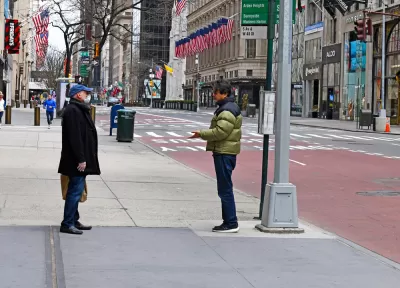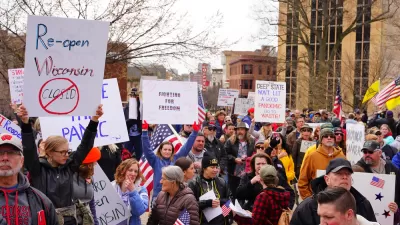To encourage recreational walking while practicing social distancing in order to reduce the spread of COVID-19, Gov. Andrew Cuomo asked the New York City mayor and city council speaker to devise a pilot project to provide for open streets.

“The plan is going to pilot closing streets in New York City because we have much less traffic in New York City. We have many fewer vehicles in New York City,” said Gov. Andrew Cuomo during Wednesday's press conference in Albany, report Berkeley Lovelace Jr., William Feuer, and Noah Higgins-Dunn for CNBC.
He said that by opening the streets, fewer people will congregate in the parks. “People want to walk. They want to go out and get some air. You want a less dense area, so pilot closing streets to cars, opening streets to pedestrians.”
In the coronavirus pandemic era, density has taken on a new meaning for Cuomo, who was the second governor to order a shut down of nonessential businesses and require social distancing on March 20 after California Gov. Newsom issued a stay at home order one day earlier. Rather than dwelling units per acre, density is all about people spacing, people per square foot, if you will.
Cuomo refers to eight of the ten measures in the PAUSE plan as density control measures, with #6 dealing with recreational activities, which he observed on Sunday was not working due to the gatherings in some parks, reported Jorge Fitz-Gibbon for the New York Post.
“It has to be reduced and it has to be reduced fast, and that’s why I’m asking for a plan from them in 24 hours,” Cuomo said during [the Sunday] press briefing, referring to Mayor Bill de Blasio and City Council Speaker Corey Johnson.
"We'll also enact mandatory playground social density – it's probably a new concept," Cuomo continued on Wednesday. "No close contact sports...no basketball, for example. You cannot do it," referring to the ability to stay away from players by six feet to adhere to social distancing guidelines. He explained that the measure was voluntary, but "if there is non-compliance, we will make it mandatory and close the playgrounds." He emphasized that the purpose of these measures is to reduce the spread of the infection.
"The city is the epicenter of a major outbreak in New York state, where cases have been doubling every three days and now account for more than half of all U.S. cases," add Lovelace Jr., Feuer, and Higgins-Dunn.
Reuters, reporting on Wednesday's briefing, indicated that by one metric, the density control measures may be working.
Hospitalizations were doubling every two days as of Sunday, but by Monday the trend showed hospitalizations were doubling every 3.4 days, and by Tuesday the rate was 4.7 days, Cuomo said.
“Now that is almost too good to be true... This is a very good sign and a positive sign, again not 100% sure it holds, or it’s accurate but the arrows are headed in the right direction,” Cuomo told a daily news conference.
Cuomo has emerged as a leading national voice on the coronavirus epidemic, which has now claimed 285 lives in the state. Positive cases rose by more than 5,000 in the past day to 30,811, Cuomo said.
On a national level, the COVID-19 death toll stands at 900 with over 64,000 cases on March 25, meaning just less than half of all cases are in New York State and almost one-third of all deaths are New Yorkers.
Related in Planetizen:
- Frontlines of the Social Distancing Effort Shifts to Parks and Open Space, March 25, 2020
-
Density in the Pandemic Era, March 18, 2020

Planetizen Federal Action Tracker
A weekly monitor of how Trump’s orders and actions are impacting planners and planning in America.

Restaurant Patios Were a Pandemic Win — Why Were They so Hard to Keep?
Social distancing requirements and changes in travel patterns prompted cities to pilot new uses for street and sidewalk space. Then it got complicated.

Map: Where Senate Republicans Want to Sell Your Public Lands
For public land advocates, the Senate Republicans’ proposal to sell millions of acres of public land in the West is “the biggest fight of their careers.”

Maui's Vacation Rental Debate Turns Ugly
Verbal attacks, misinformation campaigns and fistfights plague a high-stakes debate to convert thousands of vacation rentals into long-term housing.

San Francisco Suspends Traffic Calming Amidst Record Deaths
Citing “a challenging fiscal landscape,” the city will cease the program on the heels of 42 traffic deaths, including 24 pedestrians.

California Homeless Arrests, Citations Spike After Ruling
An investigation reveals that anti-homeless actions increased up to 500% after Grants Pass v. Johnson — even in cities claiming no policy change.
Urban Design for Planners 1: Software Tools
This six-course series explores essential urban design concepts using open source software and equips planners with the tools they need to participate fully in the urban design process.
Planning for Universal Design
Learn the tools for implementing Universal Design in planning regulations.
Heyer Gruel & Associates PA
JM Goldson LLC
Custer County Colorado
City of Camden Redevelopment Agency
City of Astoria
Transportation Research & Education Center (TREC) at Portland State University
Camden Redevelopment Agency
City of Claremont
Municipality of Princeton (NJ)





























